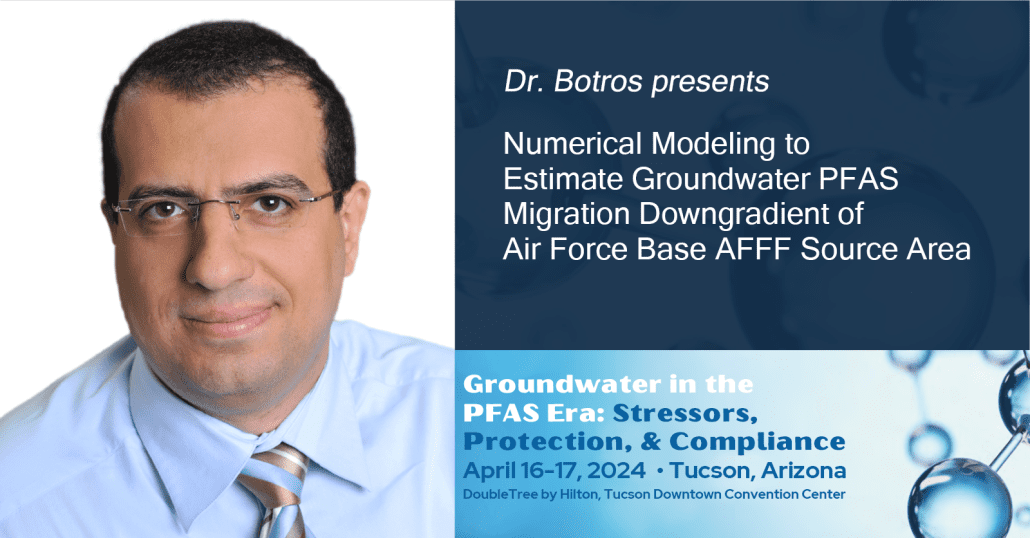Numerical Modeling to Estimate Groundwater PFAS Migration
Dr. Farag Botros, PE, will be presenting “Numerical Modeling to Estimate Groundwater Per- and Polyfluoroalkyl Substances (PFAS) Migration Downgradient of Air Force Base Aqueous Film-Forming Foam (AFFF) Source Area” at the National Ground Water Association (NGWA) Groundwater in the PFAS Era: Stressors, Protection, and Compliance event taking place on April 16 to 17, 2024, in Tucson, Arizona. Learn more about DBS&A’s PFAS Investigation expertise. Read more about PFAS regulations on the U.S. Environmental Protection Agency website.
Conference overview
The chemistry and environmental behavior of PFAS, combined with recent and proposed regulatory actions and toxicological uncertainties, create significant challenges for groundwater management and protection. This NGWA conference provides a forum to share best science and state-of-the-practice approaches to address PFAS contamination while maintaining groundwater’s essential roles for drinking water, agriculture, environmental, and other purposes. The conference provides an opportunity to share lessons learned in addressing this high-profile and rapidly evolving issue.
Presentation
Numerical Modeling to Estimate Groundwater PFAS Migration Downgradient of Air Force Base AFFF Source Area
Co-authors:
Farag Botros, PhD, PE, Gregory Schnaar, PhD, PG, Neil Blandford, PG (Daniel B. Stephens & Associates Inc.) and Amy Ewing, PG (Hazen and Sawyer)
Abstract Text:
Numerical groundwater modeling was conducted to assess potential PFAS migration from Cannon Air Force Base (AFB) in Curry County, New Mexico. Wells that have had PFAS detections or are at potential risk of future PFAS contamination were first identified and sampled, including one newly installed monitoring well downgradient of the AFB. Site hydrogeology was investigated, and potential migration pathways were determined to be coincident with paleochannels identified in the High Plains (i.e. Ogallala) aquifer.
Work began using an existing regional groundwater flow MODFLOW model that covers a large area in Texas and New Mexico, including Cannon AFB and downgradient. The results of the regional model were used to obtain the hydraulic head values at the boundaries of a smaller, local-scale groundwater model that was developed in the vicinity of the AFB using MODFLOW-NWT code. Aquifer hydraulic properties for the local model were initially taken from the existing regional model. These values were later modified during model calibration. Calibration was conducted using an automated parameter estimation program (PEST) that required more than 1,000 local model simulations to obtain optimum hydraulic conductivity values that focused on minimizing the difference between measured and simulated groundwater elevations. Automated hydraulic conductivity parameter estimation was constrained by local geologic maps including the presence and orientation of paleochannels.
The local MODFLOW-NWT model was used to simulate PFOS and PFOA fate and transport downgradient of Cannon AFB using MT3D-USGS. PFAS source location and concentrations were based on available AFB groundwater monitoring data and partition coefficients were obtained from the ITRC literature database. PFAS plumes were predicted to extend more than 1 mile from the AFB boundary to a concentration in the nanogram per liter range. Modeling results may be used to site additional monitoring wells for plume delineation and understanding the extent of potential downgradient PFAS impacts.

